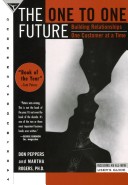 Fifteen years ago a single book changed the course of marketing. The 1-To-1 Future had been released by the consulting duo of Don Peppers and Martha Rogers. I was fortunate to hear Martha speak in 1994, as she toured heavily to promote the book’s revolutionary paradigm.
Fifteen years ago a single book changed the course of marketing. The 1-To-1 Future had been released by the consulting duo of Don Peppers and Martha Rogers. I was fortunate to hear Martha speak in 1994, as she toured heavily to promote the book’s revolutionary paradigm.
(Although we never met, I am to this day indebted to her for inspiring me to move my career from a direct response to a digital marketing focus. She also, during her talk, introduced me to the jargon-y word paradigm. For that I’m not so grateful, and do my best to use this MBA-scented doozy of a word only with heavy irony.)
The book, and the new “paradigm,” quickly generated its detractors. But much of the book has withstood the test of time.
Remember, 1994 was practically the digital stone ages. The year the book hit the marketing mainstream, was a time when frequent flier programs were still in their infancy, and the concept of “free, advertising-supported email” was one of the few internet developments worthy of mention in the first edition of the book (Hotmail was founded three years later — and went viral shortly thereafter — gobbling up market share until purchased by Microsoft).
Pioneers are often criticized for events beyond their control. I suspect that Peppers and Rogers felt more than a little queasy as they watched one corporation after another buy into large, expensive, and mostly doomed customer relationship management (CRM) initiatives. Most of the initiatives were predicated on grossly unrealistic expectations.
I predict that current and future investments in this type of marketing intelligence will deliver on the vision of this seminal book.
The truth will bear out, and we’ll see that the problem with the “one-to-one future” wasn’t the vision itself, but a dearth of analytical vigor coupled with poor training for the people actually expected to use the systems.
What will be different now? I see three things:
- Post-boom sobriety — If Pepper and Rogers had been doing business in a less explosive business environment (read: abundant venture capital mixed with what Greenspan aptly called “irrational exuberance”), their message would not have been so quickly and rudely out of fashion.
- The growth of small business — Good CRM must be wired into every part of an organization. That is nearly impossible in large, hide-bound companies. Expecially if they have two dozen databases that need to talk to each other. (Yes, two dozen. I wish I was kidding.) Thanks to the phenomena of SaaS (Software as a Service), cloud computing and good ‘ole Moore’s law, powerful business intelligence is now within reach of small and mid-market businesses. But that just the technology. Here’s the biggest difference:
- A truly plugged-in workforce — By far the largest barrier to successful implementation of automated systems is getting the workforce to recognize them as their friends. This is happening more today, as a new generation is becoming more familiar with the vast world within their web browser. It’s an entirely new way that small organizations are growing into bigger ones that I wrote about in my post on networked leadership.
For these reasons I’m optimistic about a future that fulfills Peppers and Rogers’ promise.
No, it won’t exactly be “one-to-one.” Even Peppers and Rogers conceeded that economies of scale call for more of a mass-customization of contacts and segmentation than the portfolio-based management they first discussed. But this “future” will bring us to the same destination.
It will be a scalable way to extend a business into niches as narrow the miriad reasons we choose one brand over another. Fifteen years ago I thought this book might be on to something. In spite of the economic jolt we’re experiencing (or maybe even because of it! ), the last year has assured me I wasn’t wrong after all.
It’s a mistake to talk about CRM and the 1:1 vision in the same sentence. Despite all the talk about CRM helping to “makie the right offer to the right customer at the right time, blah, blah, blah”, CRM has always been more about achieving marketing efficiency than effectiveness.
The investments made in CRM over the past 10-15 years may been cloaked in 1:1 language, but they were really about paving the marketing cowpath that already existed — i.e. outbound campaign management and execution, and inbound service execution.
Will marketers of the future get to 1:1 marketing? I agree with you that they will, but for different reasons. There are two barriers that need to be removed:
1) Branding dominance. The mentality among many marketers (especially large-firm, consumer-oriented marketers) is that “brand building” efforts take precedence over quantitative marketing efforts. Branding efforts focus on reach, awareness, and consideration. Database, or quantitative marketing efforts tend to focus on segmentation, preference, and purchase. When we achieve more parity between these two marketing approaches, 1:1 has a better chance of realization.
2) Organizational structure. Many firms are organized by product (or even geography). 1:1 marketing can only be achieved when firms organize by customer segments.